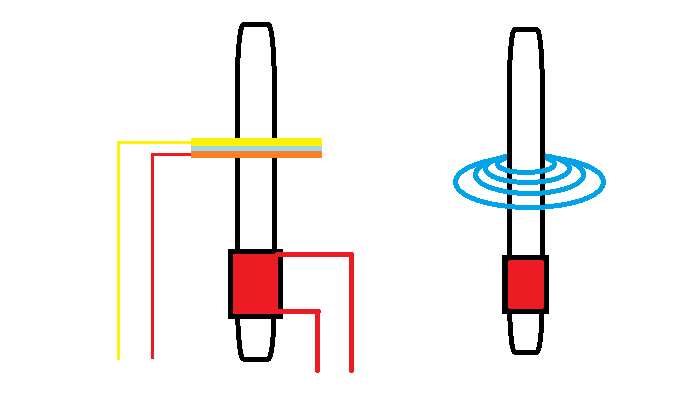Okay, the title is odd but it's the best descriptor I could think of. This post is birthed from the E P Dollard posts and not wanting to muddy the water there figured this would be best.
I've drawn up a schematic as a picture is worth a thoudand words.
Fig 1. Parrallel capacitor plates with a charge are shorted in the convential manner. The "faraday tubes of force" travel perpindicular to the plane and the result is a b field in the wire.
Fig 2. Parrallel capacitor plates with a charge are brought togther at high frequency without a shorting wire and before dielectric breakdown and results in a collapse of the E field.
Fig 3. Multiple parrallel plates with opposite porlarity are given a increase in charge to the positve plates, the replusion moves the opposite charge plates towards each other at high frequency to collapse the E field.
From pouring over research papers on electrostatic generators and HVDC currents along with the papers of JJ Thomson and Steinmetz it made me take a deeper look at condensers. I've been putting the equations together and will share them as soon as I've made some headway on them. What I've not been able to find is any reference to the effects of bringing two parrallel plates together fast enough to collapse the field before breakdown occurs and what happens at the edges of the plates. With the use of a wire to short the charge the field lines transverse the wire and give rise to a magnetic field as expected, if the plates move to slow then the a discharge occurs. If the plates of highly polished flat surfaces are in a pressurized container of highly dielectric gas and the plates are vibrating at a sufciently high enough frequency I think the collopsing field will give rise to a longitudinal wave based on the math I haven't shared yet, I know not fair but it's not finished, I just wanted to share some thoughts and see if anyone has been down this road.
Electrostatic generators if looked at from the perspective of a moving capacitor and takign note of the lines of flux exebit a 'pump' like nature in compressing and releasing the field and at sufiecintly high enough frequency or rotation will induce voltage and current due to the resultant longitudinal flux lines from the crossing of the plates and crossing the E field perpindiculary.
I also stumbled into this Dielectrophoretic pump If the link doesn't work google dielectrophoretic pump, which to me supports the idea of a capacitor E field pump as I'll call it.
The decriptors and dwgs are schematics as there is a fair amount more detail in the shape of the surface area and materials needed.
thoughts?
I've drawn up a schematic as a picture is worth a thoudand words.
Fig 1. Parrallel capacitor plates with a charge are shorted in the convential manner. The "faraday tubes of force" travel perpindicular to the plane and the result is a b field in the wire.
Fig 2. Parrallel capacitor plates with a charge are brought togther at high frequency without a shorting wire and before dielectric breakdown and results in a collapse of the E field.
Fig 3. Multiple parrallel plates with opposite porlarity are given a increase in charge to the positve plates, the replusion moves the opposite charge plates towards each other at high frequency to collapse the E field.
From pouring over research papers on electrostatic generators and HVDC currents along with the papers of JJ Thomson and Steinmetz it made me take a deeper look at condensers. I've been putting the equations together and will share them as soon as I've made some headway on them. What I've not been able to find is any reference to the effects of bringing two parrallel plates together fast enough to collapse the field before breakdown occurs and what happens at the edges of the plates. With the use of a wire to short the charge the field lines transverse the wire and give rise to a magnetic field as expected, if the plates move to slow then the a discharge occurs. If the plates of highly polished flat surfaces are in a pressurized container of highly dielectric gas and the plates are vibrating at a sufciently high enough frequency I think the collopsing field will give rise to a longitudinal wave based on the math I haven't shared yet, I know not fair but it's not finished, I just wanted to share some thoughts and see if anyone has been down this road.
Electrostatic generators if looked at from the perspective of a moving capacitor and takign note of the lines of flux exebit a 'pump' like nature in compressing and releasing the field and at sufiecintly high enough frequency or rotation will induce voltage and current due to the resultant longitudinal flux lines from the crossing of the plates and crossing the E field perpindiculary.
I also stumbled into this Dielectrophoretic pump If the link doesn't work google dielectrophoretic pump, which to me supports the idea of a capacitor E field pump as I'll call it.
The decriptors and dwgs are schematics as there is a fair amount more detail in the shape of the surface area and materials needed.
thoughts?




 I think that we can over complicate whats really simple, Its a human flaw in all of us, we see something we dont understand therefore it must be complicated and when we do find the answer its simple.
I think that we can over complicate whats really simple, Its a human flaw in all of us, we see something we dont understand therefore it must be complicated and when we do find the answer its simple.
Comment